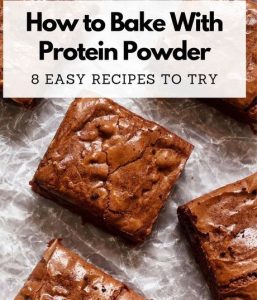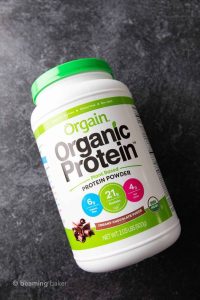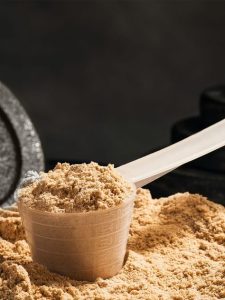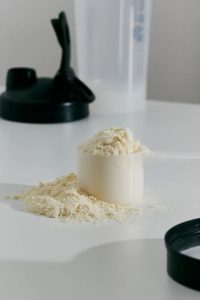
Protein powder is a popular supplement for athletes and fitness enthusiasts. But did you know you can also use protein powder in baking? This opens up a world of possibilities for creating delicious and nutritious treats. This article explores the exciting world of baking with protein powder, offering tips, tricks, and recipes to get you started.
Why Bake with Protein Powder?
There are several reasons to consider incorporating protein powder into your baking repertoire:
Increased Protein Intake:
For people who struggle to meet their daily protein needs, baking with protein powder can be a tasty way to boost protein intake.
Dietary Restrictions:
Some protein powders are vegan or gluten-free, making them suitable for people with dietary restrictions.
Flavor Exploration:
Protein powder comes in a variety of flavors, adding another dimension to your baked goods.

Things to Consider Before You Bake
Before you start replacing flour with protein powder in your favorite recipes, here are some things to keep in mind:
- Protein Powder Substitutions: Protein powder doesn’t behave exactly like flour in baking. Substituting too much protein powder can lead to dry and dense baked goods.
- Moisture Balance: Protein powder absorbs more moisture than flour. You might need to adjust the amount of wet ingredients in your recipe.
- Flavor Profile: Not all protein powder flavors work well in every recipe. Experiment to find flavor combinations you enjoy.
Tips for Baking with Protein Powder
Here are some helpful tips to ensure your protein powder adventures are a success:
- Start Small: Don’t replace all the flour in your recipe at once. Begin with a small substitution, like 25%, and gradually increase as you get comfortable.
- Use Quality Ingredients: Choose a high-quality protein powder you enjoy the taste of. Fresh baking staples like flour and eggs will also affect the outcome.
- Find Baking Inspiration: There are many online resources and recipe books dedicated to protein powder. Look for recipes that suit your taste preferences and dietary needs.

Protein Powder Baking Recipes
Here are two sample recipes to get you started on your baking journey:
High-Protein Muffins
These muffins are a delicious and nutritious way to start your day. They’re packed with protein and can be customized with your favorite mix-ins.
Ingredients:
- 1 cup rolled oats
- 1 scoop protein powder (chocolate or vanilla)
- 1 teaspoon baking powder
- ½ teaspoon baking soda
- ¼ teaspoon salt
- 1 cup milk (dairy or non-dairy)
- ½ cup mashed banana
- ¼ cup chopped nuts (optional)
Instructions:
- Preheat oven to 375°F (190°C). Line a muffin tin with paper liners.
- In a large bowl, whisk together dry ingredients (oats, protein powder, baking powder, baking soda, and salt).
- In a separate bowl, mash the banana and whisk in the milk.
- Combine the wet and dry ingredients until just combined. Fold in chopped nuts, if using.
- Fill the prepared muffin tin cups and bake for 15-20 minutes, or until a toothpick inserted into the center comes out clean.

Protein Powder Pancakes
These protein pancakes are a fluffy and satisfying option for a post-workout meal or a weekend brunch.
Ingredients:
- 1 scoop protein powder (plain or flavored)
- ½ cup rolled oats
- 1 teaspoon baking powder
- ¼ teaspoon salt
- ¾ cup milk (dairy or non-dairy)
- 1 egg
Instructions:
- In a blender, combine protein powder, oats, baking powder, and salt. Blend until a fine powder forms.
- Add the milk and egg to the blender and blend until smooth.
- Heat a lightly oiled pan or griddle over medium heat. Pour batter onto the pan in desired sizes.
- Cook for 2-3 minutes per side, or until golden brown and cooked through.
- Serve with your favorite toppings like fruit, yogurt, or nuts.
Baking with protein powder can be a fun and rewarding way to create delicious treats that fit your dietary needs. By following these tips and exploring different recipes, you can discover new ways to incorporate protein powder into your diet and enjoy tasty treats that are good for you.
Creative Recipe Exploration
Once you’ve mastered the basics of baking with protein powder, the possibilities are endless! Here are some ideas to spark your creativity:
- Protein Powder Brownies: These brownies can be a fun way to satisfy your sweet tooth with a protein boost. Experiment with different protein powder flavors to find your favorite combination.
- Protein Powder Cookies: Cookies are another classic treat that can be adapted for powder baking. Try adding chocolate chips, nuts, or dried fruit for extra flavor and texture.

Finding Inspiration
Look for inspiration online and in recipe books specifically geared towards protein powder baking. There are many resources available that cater to different tastes and dietary needs. Here are some additional tips for finding recipes:
- Focus on keywords: When searching online, use keywords like “protein powder baking recipes” or “high protein desserts.”
- Dietary filters: Many recipe websites allow you to filter recipes by dietary restrictions, such as gluten-free or vegan.
- Reviews and ratings: Look for recipes with positive reviews and ratings from other bakers. This can be a good indicator of a successful recipe.
The Science Behind Baking
Understanding some basic baking science can help you achieve even better results when using protein powder in your recipes. Here’s a brief overview:
- Protein Powder’s Role: Protein powder absorbs moisture differently than flour. This can affect the texture and density of your baked goods.
- Dry vs. Wet Ingredients: Finding the right balance between dry ingredients (like protein powder and flour) and wet ingredients (like milk and eggs) is crucial for achieving the desired texture.
- Substitutions: Not all protein powders are created equal. Experiment to find out how different protein powders affect your baking results.

Beyond the Basics
As you gain experience with protein powder, you can start to experiment with more complex recipes and techniques. Here are some ideas to consider:
- Frostings and Glazes: Many frosting and glaze recipes can be adapted for protein powder baking. This can add another layer of flavor and moisture to your treats.
- Multi-Layer Treats: Once you’re comfortable with basic recipes, try creating more elaborate desserts like protein powder cheesecakes or protein powder pies.
Conclusion
Baking with protein powder is a fun and rewarding way to create delicious and nutritious treats. With a little practice and exploration, you can discover new ways to incorporate protein powder into your diet and enjoy tasty treats that are good for you.





